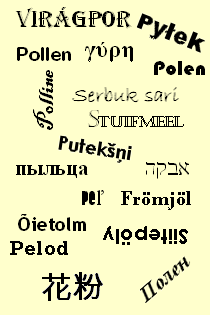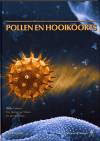Facts and Links |
||
(for fun ...)
Origin of the word "Pollen"According to the Online dictionary of etymology and Webster the word pollen as botanical term for fertilization elements in flowers was introduced in 1751 by Linnæus (new Latin pollin, pollen). Current for today is the term "palynology" for the science to study fossile pollen grains and spores (Source: van Dale).
The word "pollen" seems to originate from that for dust particles or flour, which also is indicated by the Dutch and German words "stuifmeel" and "Staubmehl" (gushing flour). The far origin of "Pollen" seems to be seeked in the Sanskrite word "palalam", which means grounded seeds. Affiliation can be found with the Old-Greek words "pale", "palunein" en "poltos": "pale" that means dust, "palunein" that means the action of dispersing flower above offer meat, and "poltos" that stays for pudder or porridge. In the Latin one finds back the word "pulvis" (genetivus "pulveris") in the significance of dust, in English the verb "pulverize" and in German "Pulver" for pudder. "Puls" is also a name indicating the gruel of cereals that formed the basic food for the Romans. Nowadays one recognizes spores of this image in the Italian "polenta", which indicates a dish made of corn grits. A connection has been made between the idea of pollen as dust particles and the Russian "pepel" which means ashes. So far for alittle bit of etymology with a wink; for more serious data we refer to scietific articles, for example like page 28 of the Indogermans dictionary. Finally, like the Dutch word "stuifmeel" the scientific term "pollen" has no plural form; thus one can speak about various types of pollen, but not about pollens. When refering to single grains the word combination pollen grain or pollen grains is appropriate, both in singular and plural. When pollen grains germinate, they begin to develop a "pollen tube".
In order to have a chance to achieve fertilization airborne pollen must be produced in large quantities. Therefore wind pollinated plants not only make a lotof pollen but they allso flower at the same time during a short period. One single inflorescence of Common Sorrel (Rumex acetosa) can produce moore than 500 million pollen grains in a few days! A plantation of Norway Spruce (Picea abies) produces per hectare 7.5 ton pollen. In spring, usually in the first two weeks of May, a layer of yellow dust can be seen on hte soil (en on the water!). One often speaks about "desert sand" or "Sahara sand".This may be the fact, but mostly the substance is in reality in May pollen of Scots Pine (Pinus sylvestris). One can easily check this with a microscope. Also in other seasons this can be observed: any idea about which plants this applies?
Pollen as nutritionAlthough airborne pollen is dispersed by the wind, it is sometimes collected by insects. In early spring bees sometimes collect pollen of the Alder and Hazel, because no other food is available. In catlings of Willows many pollen-collecting insects can be found, in particular Syrphid flies, which beside the pollen also collect the honey. Pollination in Linden is mainly achieved by wind, but bees, and moreover bumblebees can also contribute to pollination. Linden blossom is famous for its nice smell and also Linden honey is much appreciated. However, Linden pollen is not good to bumblebees: under the trees often numerous dead bumblebees can be found. Stanley and Linskens reported in their book the presence of toxic saponins in pollen of this this plant genus. However, toxic pollen is an exception. In general pollen is a healthy product with a high nutritional value (in proteins, minerals and spore elements) which can be safely consumed by insects and birds,but also by man. Pollen is so rich that in principles it contains all substances which a human needs.Pollen as object of artKeramical pollen: ceramist Birgit Vogels's graduation work on keramical techniques was inspired by scanning electron microscopy views of pollen grains from pollennieuws and the pollen morphology page of this site.
was inspired by scanning electron microscopy views of pollen grains from pollennieuws and the pollen morphology page of this site. For more information on the work of Birgit Vogels and exhibitions, surf to her website: birgitvogels.nl. LinksResearch on pollenReferences on pollen biology, hay fever and other topics related to pollen

Sites on Hay fever, Pollen counts and Hay fever forecastWebpages and photographs:Jan Derksen and Elisabeth Pierson Web development: Remco Aalbers |
||